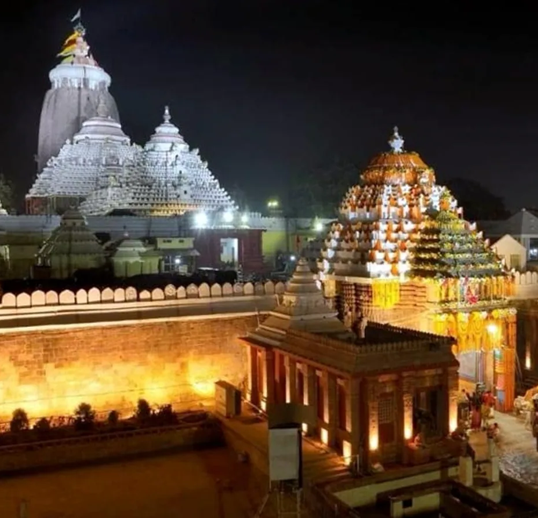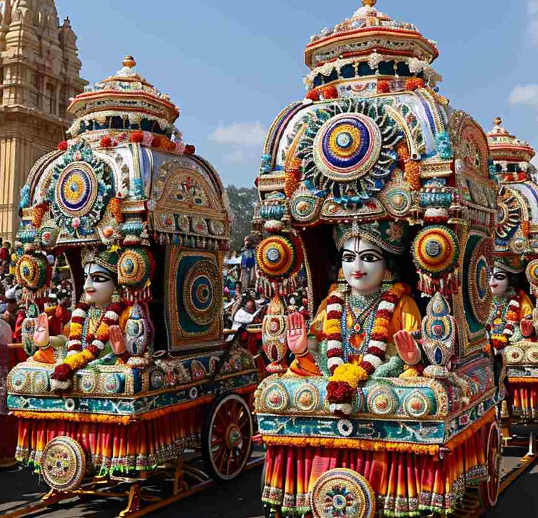

Temples in India have always fascinated travelers and residents alike, a land steeped in spirituality and rich cultural heritage, it is home to some of the world’s oldest temples which offer an awe-inspiring journey into the country’s ancient spiritual and architectural heritage. From the iconic Dwarkadhish Temple in Gujarat to the awe-inspiring Mundeshwari Devi Temple in Bihar, each temple has its own unique charm and historical significance. These architectural wonders not only showcase the country’s ancient religious practices but also serve as a testament to the craftsmanship and devotion of the people who built them.>
One such example is the Shri Jagannath Temple, Puri
Ever wondered where the English word “Juggernaut” has been derived from? Interestingly, it was first introduced to the English language in the 17th century by the European travelers who witnessed the annual Rath Yatra or the chariot festival of Shri Jagannath temple Puri in Orissa. The procession was and still is a spectacle of such grandeur accompanied by loud chanting, music, dancing and religious fervor that it started to be used metaphorically to describe any powerful, unstoppable force that demands total devotion or allegiance. It also refers to any large overpowering or relentless phenomenon.

Known the world over for this very Ratha Yatra (Chariot Festival), the Puri Shri Jagannath Temple inspires everything from devotion to intrigue and plain old curiosity.
This sacred Hindu temple is one of the most revered pilgrimages for Hindus the world over and has been built in the 10th century AD (although temple records suggest that there have always been smaller temples at that location from time immemorial). Dedicated to Shri Jagannath who is believed to be an incarnation of Shri Vishnu (the protector of the universe & one of the deities in the Hindu holy trinity), Shri Bal Bhadra (Shri Jagannath’s brother) and Maa Subhadra (his sister)
On the day of the festival, devotees throng the temple in thousands waiting for their turn to ceremoniously pull the beautiful chariot carrying the three deities up the hill to another temple and then back again. It is said that whoever pulls the chariot of the Lord is absolved of all sins. It is indeed a sight to behold!

While the Ratha Yatra is an amazing experience, the temple itself has some intriguing mysteries that have astounded devotees and scientists alike.
Flag that waves against the wind: The temple has an astounding height of 214 ft and the flag at the apex of the temple always waves against the direction of the wind. No one knows how or why.
The Nilachakra: this is a circular chakra affixed at the top of the temple and has a colossal weight of 1 ton, a diameter of almost 20 ft & visible from all parts of the city. How such a heavy object was installed almost 2000 years ago atop a 45 storey building is a huge mystery.
The absence of a shadow: The shadow of the dome of this grand temple has never been seen. We all know that every object produces a shadow when it stands against light. However, not so for the Sri Jagannath temple. One explanation given by scientists is that the shadow of the dome always falls on the building itself and hence is invisible to everybody. What an engineering marvel by our forefathers!
Absence of sound: since the temple stands very close to the beach, the sound of waves breaking on the beach is clearly audible and it’s quite loud too. But, as soon as one enters the temple, there is an absolute absence of the noise from those same waves. Ancient sound proofing?
Flag that waves against the wind: The temple has an astounding height of 214 ft and the flag at the apex of the temple always waves against the direction of the wind. No one knows how or why.
Zero waste of Maha Prasad (consecrated food): The temple serves anywhere between 2,000 to 200,000 devotees everyday. It has been recorded that no devotee goes without Prasadam from the temple premises and the amount of Prasadam is exactly that which is required to serve the last devotee who arrives there for Prasadam, not less or more.
The magical pots: The Maha Prasadam that is served to the deities is cooked in 7 earthen pots by placing one on top of the other but strangely enough, the Prasadam on the very top and hence the farthest away from the fire gets cooked first followed by the next and so on.
No fly zone: birds don’t sit on the temple gopuram and neither do they fly over the temple. As we know, birds love high buildings and are often seen perched on them. Not so in the Sri Jagannath temple. No one knows why.
This amazing temple stands tall through the ages defying scientific laws as we know them today. In some cases where we can find a scientific explanation it proves how advanced our ancient forefathers were. It is indeed something to ponder about and be proud of.